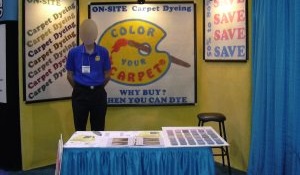Posted by Todd Hockenberry ● Mar 13, 2013
How Not to Drive Traffic to Your Trade Show Booth
Is no one showing up at your booth except 23 other exhibitors, 18 people trying to sell you something, and the show bill collector? Do you prepare for a show by making sure your backdrop is just so, your machine is running properly, your toolkit is packed with all the crap you could ever possibly need – oh yeah – did you prepare your target audience?

Does anyone know you are at the show? Were you just hoping they would stumble in front of your booth and hopefully look your way at just the right time and make eye contact so that they felt guilty enough to talk to you for a few minutes? I am exaggerating to make a point but in my experience this is not that much of stretch. You can tell that just about everyone prepares for a show in this way. We are all so busy doing the work in front of us that we start at the last minute to prepare our stuff for the show. Our stuff – totally self focused. We hope that attendees will read the directory and find us among the 7+ other companies at the show doing exactly what we are doing.
Is this passive approach a recipe for success or for mediocrity?
You are better off doing ½ or less of your usual trade shows but proactively marketing to your target audience and driving traffic that is already interested in you to your booth.
How do you proactively market for a trade show? Here are some thoughts….
- Build a landing page on your web site that educates your target customers about the latest innovation you will be showing
- Send e-mails to your current customers telling them about the show – include links to the landing page
- Buy/rent the show attendee list and contact them with a targeted message – you should sort this list to find the targets that fit your customer profile (do you know what your customer profile is?)
- Write a white paper and deliver a presentation at the show (are you a member of the host trade group and are you active?)
- Target potential customers within 200 miles of the show site and call them and arrange meetings at the show to see you solutions to their problems
But once you've done the leg work to make sure people know you are going to be at a show, you're not off the hook yet. I recently attended a large capital equipment trade show in Chicago. As I walked around and spoke with people in the booths, two things struck me as items you might want to look into before your next trade show.
The first is that very few people I spoke with were able to provide a satisfactory answer to a very basic question: “What is it about your company and products that separate you from your competitors?”The most frequent answer I heard was something along the lines of “I would have to say our quality”.
I would then ask what it was that made their quality better, and frequently heard “We build most of our equipment in-house”. Well, it turns out that the vast majority of the companies in this industry build most of their equipment in-house. So, my next questions were “How much better is your quality?” and then, “How does that quality transfer into better performance or results for your customers?”
Only a handful of people, in the more than 100 booths I visited, were able to give me answers that were even somewhat precise or backed by some kind of evidence.This is sad, and points to a very real need for the marketing people in these companies to clearly articulate compelling and well-supported reasons to buy specific products from their companies. Those reasons almost always exist; you just have to find them and then work to define, quantify and support them. This work needs to be done, and marketing needs to do it.
The second item that struck me was how casual and tired many of the booth-dwellers appeared. Some had apparently borrowed clothing from people half or twice their size. Others were sitting and playing with their computers, tablets/phones, didn't even bother to look up when a person wandered into their booth and stared at a machine. I saw one guy sitting on a platform and leaning back against the machine his company was paying to exhibit at the show. His eyelids at half-mast, I decided not to disturb him. I’m sure potential customers felt the same way I did.
Now, I know from experience that as a show heads into its third day, the energy and enthusiasm of booth-dwellers and show-goers tends to wane. But always remember that the people who staff your booth at a trade show are the face of your company. The way they look, their level of enthusiasm, their knowledge about your products and company, and the way they engage visitors at your booth are all extremely important.
So, before your next trade show, put some thought into the marketing messages you want your people to convey to your prospects. Make sure the messages are clear, really differentiate you from your competitors, and are backed up by customer testimonials and performance data. And to address the fatigue issue, consider rotating some fresh faces into your booth every day. You’ll increase the odds that your people will successfully engage visitors who could turn into prospects and then into customers who buy your products. Which is the main reason why you invest your money to exhibit at a trade show in the first place.
How do you proactively market and prepare for trade shows? Let us know in the comments below.
Topics: Marketing, Tradeshows





